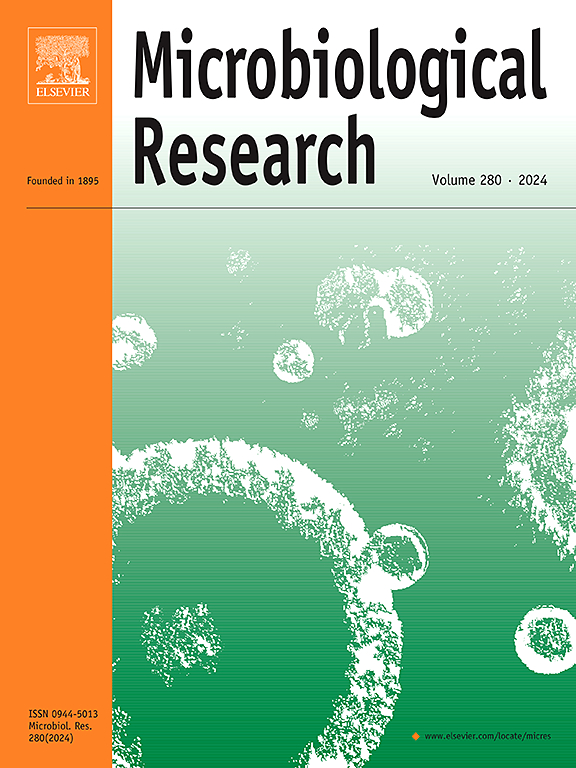Unravelling the enzymatic wood decay repertoire of Cerrena zonata: A multi-omics approach
IF 6.1
1区 生物学
Q1 MICROBIOLOGY
引用次数: 0
Abstract
Lignocellulosic biomass (LCB), such as wheat straw, bagasse, or wood, is a cost-effective, sustainable carbon source but remains challenging to utilize due to the recalcitrance of lignin, which hinders efficient carbohydrate hydrolysis. Effective LCB degradation demands a wide range of enzymes, and commercial enzyme cocktails often require physical or chemical pretreatments. A fully enzymatic degradation could drastically improve the efficiency of these processes. Basidiomycota fungi naturally possess diverse enzymes suited for LCB breakdown. The white-rot fungus Cerrena zonata, a member of the phylum Basidiomycota, was analyzed for its Carbohydrate-Active Enzymes (CAZymes) using a multi-omics approach. Genomic and transcriptomic analyses of C. zonata identified 20,816 protein-encoding genes, including 487 CAZymes (2.3 %). Cultivating C. zonata with and without LCB addition revealed a total of 147 proteins, of which 36 were CAZymes (13 auxiliary activities (AA), 3 carbohydrate esterases, and 20 glycoside hydrolases). In accordance, laccase, manganese peroxidase (MnP) as well as versatile peroxidase (VP) activities were detected in the fungal culture supernatants. Furthermore, relevant enzymes were visualized via zymography. Consistent with these results, five putative peroxidases (AA2) and three putative laccases (AA1_1) were identified in all –omics dimensions. Further structure and sequence analysis of AA2 proteins supports that two proteins were classified as VPs and three as MnPs, based on their active and Mn2 + binding sites. In summary, C. zonata possesses a broad enzyme spectrum expressed under varied conditions, highlighting its potential for identifying efficient lignin-degrading enzymes for enzymatic pretreatment of food industry side streams and other LCBs.
解开酶的木材腐烂曲目的Cerrena zonata:一个多组学的方法
木质纤维素生物质(LCB),如麦秸、甘蔗渣或木材,是一种具有成本效益的可持续碳源,但由于木质素的顽固性,阻碍了有效的碳水化合物水解,因此利用起来仍然具有挑战性。有效的LCB降解需要多种酶,而商业酶混合物通常需要物理或化学预处理。完全的酶降解可以大大提高这些过程的效率。担子菌属真菌天然具有多种适合LCB分解的酶。采用多组学方法对担子菌门白腐菌Cerrena zonata的碳水化合物活性酶(CAZymes)进行了分析。基因组和转录组学分析鉴定出20,816个蛋白质编码基因,其中包括487个CAZymes(2.3 %)。添加LCB和不添加LCB共培养出147种蛋白质,其中酶类36种(辅助活性酶13种,糖酯酶3种,糖苷水解酶20种)。真菌培养上清液中检测了漆酶、锰过氧化物酶(MnP)和多功能过氧化物酶(VP)的活性。此外,通过酶谱法对相关酶进行可视化分析。与这些结果一致,在所有组学维度上鉴定出5种推定的过氧化物酶(AA2)和3种推定的漆酶(AA1_1)。进一步对AA2蛋白的结构和序列分析表明,根据活性位点和Mn2 +结合位点,2个蛋白被归类为VPs, 3个蛋白被归类为MnPs。综上所述,C. zonata具有在不同条件下表达的广泛酶谱,突出了其在食品工业侧流和其他lcb的酶预处理中鉴定高效木质素降解酶的潜力。
本文章由计算机程序翻译,如有差异,请以英文原文为准。
求助全文
约1分钟内获得全文
求助全文
来源期刊

Microbiological research
生物-微生物学
CiteScore
10.90
自引率
6.00%
发文量
249
审稿时长
29 days
期刊介绍:
Microbiological Research is devoted to publishing reports on prokaryotic and eukaryotic microorganisms such as yeasts, fungi, bacteria, archaea, and protozoa. Research on interactions between pathogenic microorganisms and their environment or hosts are also covered.
 求助内容:
求助内容: 应助结果提醒方式:
应助结果提醒方式:


